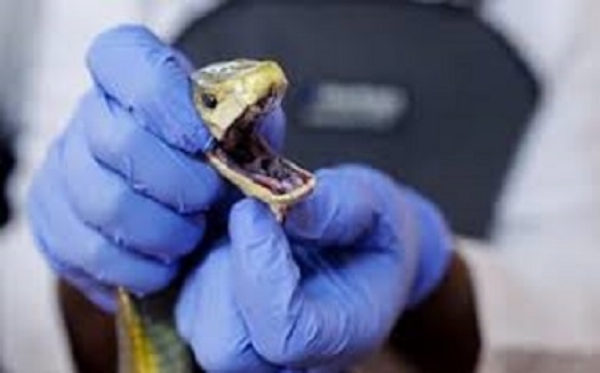
Dr R B Chaudhary
Snakebites claim countless lives every year, with millions of envenomations occurring globally, particularly in rural and developing regions. However, a groundbreaking development in antivenom research could change this grim reality. On May 2, 2025, Cell Press published a study detailing the creation of the most broadly effective antivenom to date, capable of neutralizing the neurotoxins of 19 of the world’s deadliest snakes, including the black mamba, king cobra, and tiger snake. This article explores this revolutionary antivenom, its development, and its potential to save lives worldwide.
According to the World Health Organization (WHO), snakebites cause approximately 81,000 to 138,000 deaths annually, with up to 400,000 people suffering permanent disabilities. Most victims live in tropical and subtropical regions, particularly in Africa, Asia, and Latin America, where access to medical care is limited. The WHO classifies venomous snakes into categories based on their medical significance, with Category 1 and 2 snakes, such as cobras, mambas, and taipans, being the most dangerous due to their potent neurotoxins, which can paralyze victims and lead to death within hours.
Traditional antivenom production, unchanged for over a century, involves injecting animals like horses or sheep with venom from a single snake species to produce antibodies. These antibodies are then harvested and used to treat bites. However, this method has significant limitations: it’s species-specific, often causes adverse reactions due to non-human antibodies, and is less effective in regions with diverse snake populations. The need for a universal antivenom—one that can neutralize venom from multiple snake species—has long been a goal of researchers.
The new antivenom, described in the May 2, 2025, Cell Press journal Cell, owes its success to an extraordinary human donor, Tim Friede. Over 18 years, Friede deliberately exposed himself to venom from ۱۶ highly lethal snake species, building a self-induced hyper-immunity. This unique immune history allowed his body to produce antibodies capable of neutralizing a wide range of snake neurotoxins. “The donor’s once-in-a-lifetime immune history was exciting,” said Jacob Glanville, CEO of Centivax, Inc., and first author of the study. “It could give rise to a broad-spectrum or universal antivenom.”
Researchers, led by Glanville and Peter Kwong, formerly of the National Institutes of Health and now at Columbia University, harnessed Friede’s antibodies to create a powerful antivenom cocktail. They tested it against 19 of the WHO’s Category 1 and 2 deadliest snakes from the elapid family, which includes about half of all venomous snakes, such as coral snakes, mambas, cobras, and kraits. The elapid family is notorious for its neurotoxic venom, which attacks the nervous system, causing paralysis and respiratory failure.
The antivenom is a three-component cocktail designed to neutralize a broad spectrum of elapid venoms. The process began with isolating antibodies from Friede’s blood that reacted with neurotoxins from the 19 snake species. These antibodies were tested in mice injected with lethal doses of venom from each species. The team systematically built the cocktail to include the minimum number of components needed for maximum effectiveness.
LNX-D09 Antibody is antibody, derived from Friede, protected mice against venom from six snake species. Varespladib is a small molecule known to inhibit toxins, it extended protection to three additional species. SNX-B03 Antibody is another antibody from Friede, it completed the cocktail, providing full protection against 13 of the 19 species and partial protection against the remaining six.
This three-part mixture demonstrated “dramatically unparalleled breadth,” according to Glanville. The team believes it could be effective against many other elapid snakes not included in the study, potentially covering a significant portion of the 350+ venomous snake species worldwide.
While the antivenom has shown remarkable success in mouse trials, the next step is real-world testing. The team plans to trial the antivenom on dogs bitten by snakes in Australian veterinary clinics, where snakebites are common. They also aim to develop a second antivenom targeting vipers, the other major family of venomous snakes, which includes rattlesnakes and adders. Vipers produce hemotoxic venom, which destroys tissue and causes severe bleeding, requiring a different approach.
The ultimate goal is a single, pan-antivenom cocktail or two separate cocktails—one for elapids and one for vipers—to cover all major venomous snakes. However, challenges remain. Producing and distributing the antivenom on a large scale requires significant funding and collaboration with pharmaceutical companies, governments, and philanthropic organizations.
“Although there are millions of snake envenomations per year, the majority are in the developing world, disproportionately affecting rural communities,” Glanville noted, highlighting the need for equitable access. The research was supported by the National Institute of Allergy and Infectious Diseases, the National Institutes of Health Small Business Innovation Research program, and the US Department of Energy, underscoring its scientific credibility and potential impact.
This breakthrough antivenom represents a monumental step toward reducing the global burden of snakebites. By leveraging a human donor’s unique immunity and combining it with innovative science, researchers have created a versatile and effective treatment that could save countless lives. As testing progresses and partnerships form, the dream of a universal antivenom is closer than ever, offering hope to millions in snakebite-prone regions. (The author is senior journalist and science writer associated with Hindusthan Samachar as Representative of Tamilnadu State)
---------------
Hindusthan Samachar / Dr. R. B. Chaudhary








